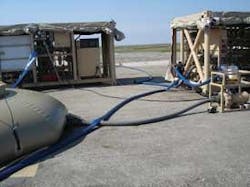Alion Builds Navy Water Filtration Plant with Industrial-Size Applications
• Whether for aircraft carriers, disaster relief, or other military or humanitarian missions, the U.S. Navy’s Expeditionary Unit Water Purification (EUWP) program deals in industrial-size problems.
by Donald W. Haun, Jr.
Water is a critical lifeline for industry whether to cool machinery or provide drinking water for an offshore rig. When natural disaster strikes, an industrial accident occurs, or it’s needed for industrial purposes, water can be contaminated by biological, radiological or chemical agents.
At such times, industry must be able to transform the contaminated water into potable or process water. This helps public and private communities ward off disease associated with water contamination, and it can prevent ecological challenges caused by release of contaminated water into the environment. Thanks to the Office of Naval Research’s Expeditionary Unit Water Purification (EUWP) program, brackish or polluted water can be purified and distributed quicker using portable purification plants.
Alion Science & Technology, of McLean, VA, is building on the advanced technology being developed under EUWP. It recently delivered a full-scale technology demonstrator of an advanced water purification plant that can produce over 300,000 gallons per day (gpd) of potable-grade freshwater on a naval aircraft carrier. This system can sustain a devastated community with clean drinking water for quite a long time. Using microfiltration pretreatment membrane technology and high recovery reverse osmosis (RO) membranes, it also can increase the purity level of a portion of the potable output and produce over 100,000 gallons per day of high-purity boiler feedwater.
The technology demonstrator incorporates new machinery and developmental components along with an integrated chemical cleaning technology to produce cleaner water, significantly reduce energy consumption, and decrease the size and weight of the plant as compared to present naval desalination plants.
This has huge ramifications for adaptable mobile units. According to the Office of Naval Research (ONR) website, an EUWP demonstrator system was deployed to Port Clarence, AK, in July 2005 after the water supply was contaminated during a storm surge. Two months later, two demonstrator units were sent to Biloxi and Pascagoula, MS with great success to provide drinking water for the victims of Hurricane Katrina. These units can be deployed anywhere contaminated water must be purified. Whether it’s being used to help in disaster scenarios or to simply ensure a chemical plant is releasing water as pure as the water it’s bringing in, the system can have a real impact.
Under the Navy contract, Alion provided engineering and program management expertise to oversee the demonstrator system’s conceptual design, fabrication, and all system and software engineering development. Alion also spearheaded creation of technical documentation, factory acceptance testing and safety assessments as part of its program management responsibilities.
The water purification plant was designed to operate in both harbor as well as shoreline waters. It incorporates new machinery and chemical technologies to significantly reduce energy consumption, size and weight over current naval desalination plants. It can also operate for extended periods of time in coastal waters that require greater filtration.
Village Marine Tec, a leader in RO treatment system design for watercraft and vessels, teamed with Alion under the Navy contract to provide expertise they gained in building the first generation, 100,000-gpd mobile water purification plant for the EUWP program.
Acknowledgment: The author thanks Gardena, CA-based Village Marine Tec (www.villagemarine.com) and the U.S. Office of Naval Research (www.onr.navy.mil) for assistance on this project.
About the Author: Donald W. Haun, Jr. is Alion Science and Technology’s senior program manager in the JJMA Maritime Sector. Contact: 877-771-6252 or www.alionscience.com




